Vietinghoff – the Mystic and his Contemporaries
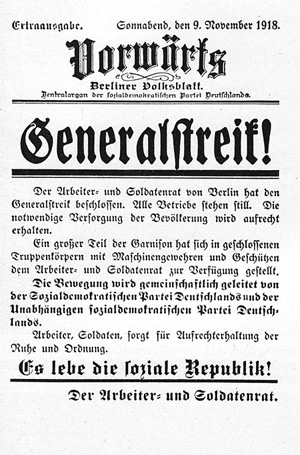 Egon von Vietinghoff's birth and artistic awakening belongs to an era of several revolutions, particularly socio-political ones (partly due to World War II) such as the collapse of centuries old monarchies in the short period from 1910 to 1924 in Greece, Portugal and the multi-ethnic empires in China, Mongolia, Austria (including Hungary, Czech, Slovakia and the Balkan) and Turkey, Syria, Lebanon (Ottoman empire). Last but not least, the revolutions in Germany and Russia were both decisive in the history of the Vietinghoff family.
Egon von Vietinghoff's birth and artistic awakening belongs to an era of several revolutions, particularly socio-political ones (partly due to World War II) such as the collapse of centuries old monarchies in the short period from 1910 to 1924 in Greece, Portugal and the multi-ethnic empires in China, Mongolia, Austria (including Hungary, Czech, Slovakia and the Balkan) and Turkey, Syria, Lebanon (Ottoman empire). Last but not least, the revolutions in Germany and Russia were both decisive in the history of the Vietinghoff family.In Egon's biography, music and literature were already "occupied" by his father and mother, both of them distinctive personalities. Thus, their sensual son found in the fine arts an inviting field for his youthful start to his career.
This area was popular among other sensitive and creative people as well because the fine arts were as exposed to fundamental change as the political and social structures.
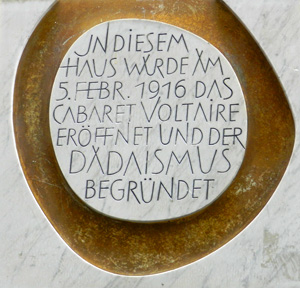 Young Egon was confronted with multiple "isms" with which the present layman is no longer familiar (in alphabetic order): Alogism, Concretism, Constructivism, Cubo-Futurism, Fauvism, Futurism, Minimalism, Neo-Plasticism, Orphism, Primitivism, Projectionism, Rayonism, Simultanism, Suprematism, Tachism, Symbolism, Tubularism, and Vibrationism. In modern general education, there still remains after Impressionism, only Expressionism, Cubism, Dadaism, and Surrealism.
Young Egon was confronted with multiple "isms" with which the present layman is no longer familiar (in alphabetic order): Alogism, Concretism, Constructivism, Cubo-Futurism, Fauvism, Futurism, Minimalism, Neo-Plasticism, Orphism, Primitivism, Projectionism, Rayonism, Simultanism, Suprematism, Tachism, Symbolism, Tubularism, and Vibrationism. In modern general education, there still remains after Impressionism, only Expressionism, Cubism, Dadaism, and Surrealism.Vietinghoff soon considered these styles, trends, proposals, fragments and ideological fractions as dead ends, fashion or phantasm.
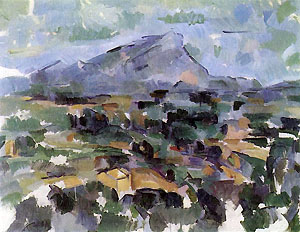 Comparing his works with those of his contemporaries, it is hard to imagine a common denominator without describing the atmosphere at that time.
Comparing his works with those of his contemporaries, it is hard to imagine a common denominator without describing the atmosphere at that time.The common roots of the mentioned artistic currents and Vietinghoff's individual path lay in their insight that painting needed a fundamental philosophical and creative renewal after the period of Romanticism, academic realism and dogmatized Impressionism of the 19th century. The only question was how radical. Only modifying the existing representationalism (for example Cezannenism) or completely opposing it ultimately depends on the single personality.
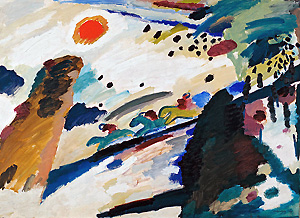 The somewhat hidden common denominator of Vietinghoff's idea and that of his contemporaries is the demand for origin, purity and relief from academic and conventional ballast which restrained spontaneity and obstructed truth.
The somewhat hidden common denominator of Vietinghoff's idea and that of his contemporaries is the demand for origin, purity and relief from academic and conventional ballast which restrained spontaneity and obstructed truth.Kandinsky, Malevich, Delaunay, Klee and Itten spoke about "pure reality", "pure energy", "pure colors", "pure composition" and "pure visions" while Vietinghoff developed his School of Pure Vision.
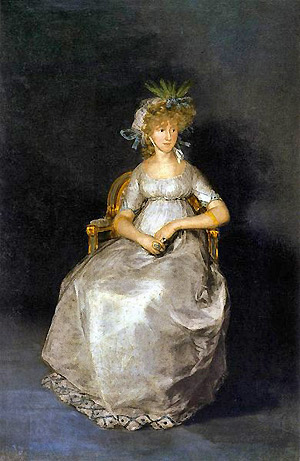 Two issues of equal importance attracted his attention in another direction from the avant-garde at that time. First, with a negative prefix, the attempts to find an escape from the decade old crisis in painting art were completely unsatisfying and confusing in both the debates and the artistic results. Second, with a positive prefix, the fascination with technically highly developed works of a successive genius in the European tradition of painting whose last authorities he considered to be Goya and Turner.
Two issues of equal importance attracted his attention in another direction from the avant-garde at that time. First, with a negative prefix, the attempts to find an escape from the decade old crisis in painting art were completely unsatisfying and confusing in both the debates and the artistic results. Second, with a positive prefix, the fascination with technically highly developed works of a successive genius in the European tradition of painting whose last authorities he considered to be Goya and Turner.Most beholders, especially the art critics and gallery owners, think Vietinghoff's turning to the Old Masters was only a regression to "good old times". This may be true inasmuch as he was not willing to join the Dadaistic pranks and jokes or to submit to the dictate of any short-lived theory.
Yet, it is a great misjudgment as he did not unconditionally dedicate himself to the past and was critical even of the best painters of any heyday.
Certainly, he distinguished an inspired success from a tame commissioned piece, works of the master from workshop productions, the sensibility of a small sketch from an extensive execution, artistic depth of youth from mature individual periods and genuine from ascribed paintings.
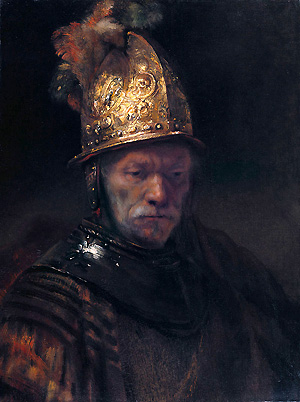 For example, his unerring sense for transcendental art recognized that the "Man in the Golden helmet" in Berlin, which was thought to be painted by Rembrandt, could not belong to the oeuvre of this outstanding master, and this decades prior to its deletion (1986) from the working list of Rembrandt only after extensive scientific examination.
For example, his unerring sense for transcendental art recognized that the "Man in the Golden helmet" in Berlin, which was thought to be painted by Rembrandt, could not belong to the oeuvre of this outstanding master, and this decades prior to its deletion (1986) from the working list of Rembrandt only after extensive scientific examination. Egon von Vietinghoff was not interested in the categories of "old" and "new", historical or progressive, but in the capacity of an artist to be visually deeply moved due to a metaphysical experience. This refers to the purely intuitive imagination, focused solely on color play, and to the skillful transformation on the canvas. In all periods of art there were "deep" and "flat" works, in Vietinghoff's terms "transcendental" and "non transcendental". The first of which are "seen from the inside", flowing from inspiration and highlighted by mystic insights. The second are naturalistic, inane and describing only external characteristics.
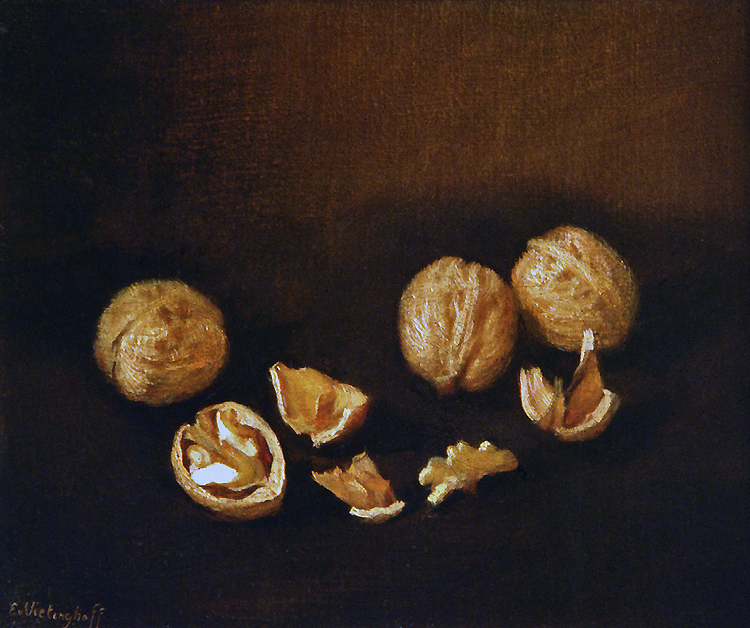 In the comings and goings between old and new, Vietinghoff searched as far as possible for a third timeless view whose criteria was (also in general, still today) not bound by time. His transcendental experiences as a painting mystic provided him a transcendental standard which is timeless. With this aid, he revealed the approach and works of many of his somewhat helpless contemporaries to be shallow or – even worse – as consciously deceiving or born from egocentric and mercantile intentions. For example, if titles including the terms like "Metaphysics" or "metaphysical" should increase the value of insipid pictures, if collages with newspapers or kitchen cutlery and plasticized human excrements are exhibited as great art works or if the cult of personality of the artist becomes the main subject.
In the comings and goings between old and new, Vietinghoff searched as far as possible for a third timeless view whose criteria was (also in general, still today) not bound by time. His transcendental experiences as a painting mystic provided him a transcendental standard which is timeless. With this aid, he revealed the approach and works of many of his somewhat helpless contemporaries to be shallow or – even worse – as consciously deceiving or born from egocentric and mercantile intentions. For example, if titles including the terms like "Metaphysics" or "metaphysical" should increase the value of insipid pictures, if collages with newspapers or kitchen cutlery and plasticized human excrements are exhibited as great art works or if the cult of personality of the artist becomes the main subject. 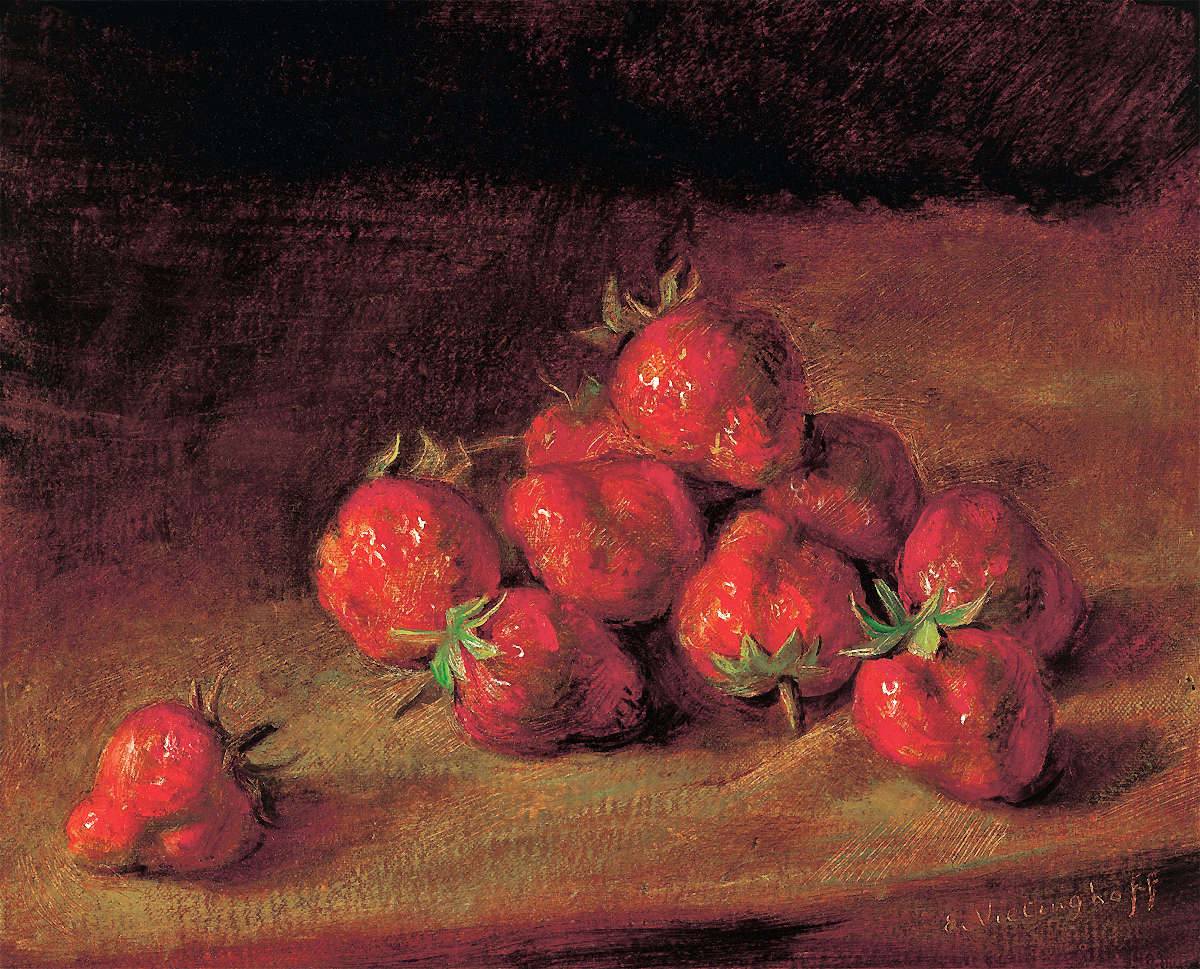 It was not Vietinghoff's nature to imitate, scandalize, bluff or to pull the wool over the public's eyes, or in other words to go an easy way. He considered it ridiculous to "dynamo-declaim poet-metalogical records" (text on a poster for a Russian Dada event) instead of recite verses. His standards were different than to attract by alienation or poppycock.
It was not Vietinghoff's nature to imitate, scandalize, bluff or to pull the wool over the public's eyes, or in other words to go an easy way. He considered it ridiculous to "dynamo-declaim poet-metalogical records" (text on a poster for a Russian Dada event) instead of recite verses. His standards were different than to attract by alienation or poppycock. 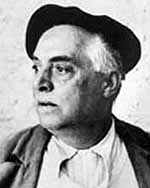 Not all which is called "metaphysical" is really metaphysical; what claims to be "mystical" is often just toying with the idea and rather remains on a mysterious level. A further parallel to another contemporary of Vietinghoff is interesting: the quest for transcendental painting of Giorgio de Chirico (1888-1978) and the subsequent backtrack in his creation. Especially inspired by Arnold Böcklin and Friedrich Nietzsche, he is considered to be a precursor of Surrealism, as he first developed his "Metaphysical Painting" in 1911 and founded the "Metaphysical School" in 1917 together with the futurist Carlo Carrà (1881-1966). It lasted only until 1920 due to a difference of opinion. Can such demanding art solely depend on this?
Not all which is called "metaphysical" is really metaphysical; what claims to be "mystical" is often just toying with the idea and rather remains on a mysterious level. A further parallel to another contemporary of Vietinghoff is interesting: the quest for transcendental painting of Giorgio de Chirico (1888-1978) and the subsequent backtrack in his creation. Especially inspired by Arnold Böcklin and Friedrich Nietzsche, he is considered to be a precursor of Surrealism, as he first developed his "Metaphysical Painting" in 1911 and founded the "Metaphysical School" in 1917 together with the futurist Carlo Carrà (1881-1966). It lasted only until 1920 due to a difference of opinion. Can such demanding art solely depend on this? 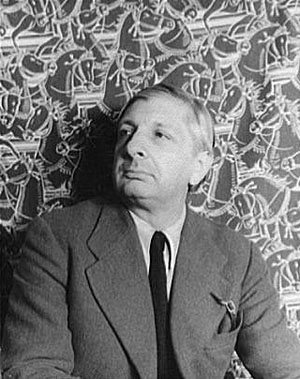 In the time from 1924 to 1932/33, Vietinghoff and de Chirico simultaneously lived in Paris and met each other. We can only guess what kind of discussions on painting and metaphysics they may have had at the artists’ reunions in the famous coffee shops – even considering that the 15 year senior Giorgio de Chirico was already a well-known man at that time, but Egon von Vietinghoff was still in his beginnings.
In the time from 1924 to 1932/33, Vietinghoff and de Chirico simultaneously lived in Paris and met each other. We can only guess what kind of discussions on painting and metaphysics they may have had at the artists’ reunions in the famous coffee shops – even considering that the 15 year senior Giorgio de Chirico was already a well-known man at that time, but Egon von Vietinghoff was still in his beginnings. Despite their shared discontent with the world situation at that time and the desire of both to also reflect on the essential in art, the differences between de Chirico and Vietinghoff are remarkable. The Italian deliberately presented an unfamiliar world with unconventional perspectives, unusual lighting and shadows and a gloomy sky over bleak architecture. Often, he emphasized the "metaphysical" character of the strange and stage-like scenery by enigmatic titles such as "The nostalgia of the Infinite", "The Enigma of a Day", "Metaphysical Interior" or "Melancholy and Mystery of a Street". Typically his paintings, if not deserted, show a wooden faceless jointed doll with symbolic objects such as clocks in mysterious, somewhat eerie atmospheres.
These figures represent the alienated human lost in the world during and after World War I. The entire effect should recall the metaphysical and transcendental aspect of life.
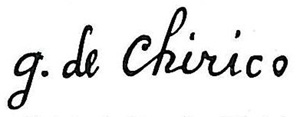 However, one of the most important characteristics of mysticism is the genuine and in a larger sense cosmic-religious experience (!) which does not result from cognitive intention. In 1930, de Chirico completely turned away from this path and from other currents in art – like Vietinghoff and others did – and reoriented toward the Italian past. He dedicated himself intensively to still lifes, portraits, mythological scenes and paintings with horses, and even became a strong critic of modern art, as did Vietinghoff.
However, one of the most important characteristics of mysticism is the genuine and in a larger sense cosmic-religious experience (!) which does not result from cognitive intention. In 1930, de Chirico completely turned away from this path and from other currents in art – like Vietinghoff and others did – and reoriented toward the Italian past. He dedicated himself intensively to still lifes, portraits, mythological scenes and paintings with horses, and even became a strong critic of modern art, as did Vietinghoff. As he could not earn enough with these less spectacular representational paintings in a rather traditional style, he later copied and sold some works of his former "Metaphysical Art", which received much more recognition. However, Carlo Carrà continued to develop his "Magic Realism" from their common successful ideas.
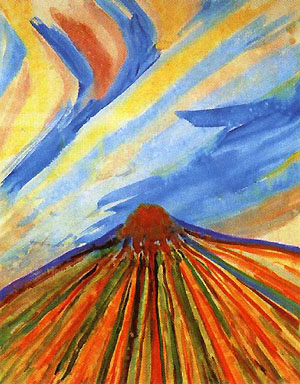 From 1919 to 1926, Mikhail Matyushin (1861-1934) made experiments of perception which he called "broadened seeing". He tried to train the eyes to move independently. Then, the artist could simultaneously look in two directions in order to comprehend the "cosmic and directionless nature of space". He invented instruments to broaden the limits of the visual perception which would advance to a new experience of spatial depth and movement.
From 1919 to 1926, Mikhail Matyushin (1861-1934) made experiments of perception which he called "broadened seeing". He tried to train the eyes to move independently. Then, the artist could simultaneously look in two directions in order to comprehend the "cosmic and directionless nature of space". He invented instruments to broaden the limits of the visual perception which would advance to a new experience of spatial depth and movement. This springs from a materialistic conception of the world which attempts to overcome the limitations of the human horizon in a mechanical and physiological way.
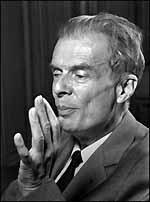 In around 1950, Aldous Huxley carried out completely different experiments of perception under the influence of mescaline which he described in his book The Doors of Perception (published in 1954). Years later, Vietinghoff read it with great interest and found several important parallels confirming his own experiences.
In around 1950, Aldous Huxley carried out completely different experiments of perception under the influence of mescaline which he described in his book The Doors of Perception (published in 1954). Years later, Vietinghoff read it with great interest and found several important parallels confirming his own experiences. Nevertheless, he was never inclined to artificially bring about a psychedelic state in order to deepen his view. Thus, he did not recommend any drugs for heightening awareness. Also this method to overcome the narrowness of daily perception was not in accordance with nature – he found a softer and more natural method, in a larger sense a meditative one.
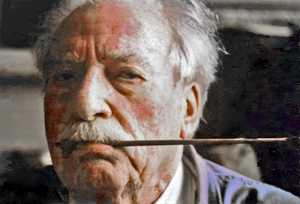 Vietinghoff's way lead him through a contemplative discipline of seeing, from the School of Pure Vision to his concept of Transcendental Painting. By doing so, he went through a harmonic and internalized process without external influence. With a certain "relaxed concentration" and trust in the metaphysical foundation of existence, he built an energy field of ready reception. Thus, he put himself in a waiting position, in a quasi-mediumistic attentiveness.
Vietinghoff's way lead him through a contemplative discipline of seeing, from the School of Pure Vision to his concept of Transcendental Painting. By doing so, he went through a harmonic and internalized process without external influence. With a certain "relaxed concentration" and trust in the metaphysical foundation of existence, he built an energy field of ready reception. Thus, he put himself in a waiting position, in a quasi-mediumistic attentiveness. 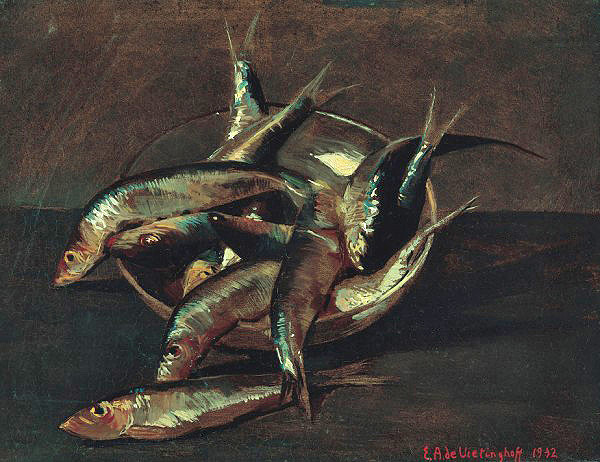 He specifically focused his eyes to dissolve the habitual trivial view without external influence or increased effort and achieved the connection to the non physical (metaphysical) dimension of existence. This view opened due to internal composure.
He specifically focused his eyes to dissolve the habitual trivial view without external influence or increased effort and achieved the connection to the non physical (metaphysical) dimension of existence. This view opened due to internal composure.In a reduced and playing frame, we know such visual phenomena when looking at a picture whose image changes after a long, relaxed "contemplation" without any effort of will (this kind of optical illusion is also known as "picture puzzle" or "hidden face"). This comparison is given to show that in both situations only a kind of meditation is the way to see the "hidden message" whereas tension, will and meticulousness do not help.